21.1: Money as a Tool
21.1.1: Functions of Money
The main functions of money are as a medium of exchange, a unit of account, and a store of value.
Learning Objective
Describe the function of money
Key Points
- When money is used to intermediate the exchange of goods and services, it is performing a function as a medium of exchange.
- A unit of account is a standard numerical unit of measurement of the market value of goods, services, and other transactions.
- To act as a store of value, money must be able to be reliably saved, stored, and retrieved. In this case, the value of the money must also remain stable over time.
- Money can also function as a “standard of deferred payment,” which means that its status as legal tender allows it to function for the discharge of debts.
Key Terms
- medium of exchange
-
An intermediary used in trade to avoid the inconveniences of a pure barter system, such as money.
- unit of account
-
a standard monetary unit of measurement of value/cost of goods, services, or assets.
- store of value
-
An asset such as money or gold that is purchased or accepted as payment for goods and services for its ability to purchase other assets in the future without rapidly losing its purchasing power.
Example
- After World War II, at the Bretton Woods Conference, most countries adopted fiat currencies that were fixed to the U.S. dollar. In turn, the U.S. dollar was fixed to gold. In 1971, the U.S. government suspended the convertibility of the U.S. dollar to gold.
Money acts as a standard measure and common denomination of trade. As a result, it is a basis for quoting and bargaining prices. It is necessary for developing efficient accounting systems, but its most important use is that it provides a method to compare the values of dissimilar objects. Money functions as:
- A medium of exchange
- A unit of account
- A store of value
A Medium of Exchange
When money is used to intermediate the exchange of goods and services, it is performing the function of a medium of exchange. It avoids the inefficiencies of a barter system, such as the dependence on the occurrence of a coincidence of wants. To be widely acceptable, a medium of exchange should have stable purchasing power. Therefore, it should possess the following characteristics:
- Valuation of common assets
- Constant utility
- Low cost of preservation
- Transportability
- Divisibility
- High market value in relation to volume and weight
- Recognizability
- Resistance to counterfeiting
Gold was popular as a medium of exchange and store of value because it was inert. Gold was convenient to move because even small amounts of it had considerable value. Gold also had a constant value due to its special physical and chemical properties, which made it cherished by men.
A Unit of Account
A unit of account is a standard numerical unit of measurement of the market value of goods, services, and other transactions. Also known as a “measure” or “standard” of relative worth and deferred payment, a unit of account is a necessary prerequisite for the formulation of commercial agreements. To function as a unit of account, whatever is being used as money must meet these characteristics:
- It must be divisible into smaller units without a loss of value. For example, precious metals can be coined from bars or melted down into bars again.
- It must be fungible. In other words, one unit or piece must be perceived as equivalent to any other. This is why diamonds, works of art, or real estate are not suitable as money.
- It must have a specific weight, measure, or size in order to be verifiably countable. For instance, coins are often milled with a reeded edge, so that any removal of material from the coin (lowering its commodity value) will be easy to detect.
A Store of Value
To act as a store of value, money must be able to be reliably saved, stored, and retrieved. Moreover, it must be predictably usable as a medium of exchange when it is retrieved. The value of the money must also remain stable over time. Put simply, money acting as a store of value allows its owner to transfer real purchasing power from the present to the future. Some have argued that inflation, by reducing the value of money, diminishes its ability to function as a store of value. Money can also function as a “standard of deferred payment,” which means that its status as a legal tender allows it to function for the discharge of debts.
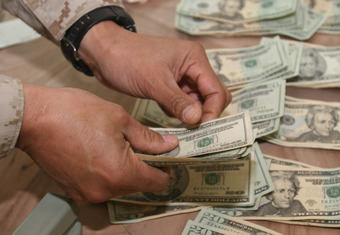
Functions of Money
Money, such as the U.S. dollar, functions as a medium of exchange, a unit of account, and a store of value.
21.1.2: Types of Currency
Nearly all contemporary money systems are based on fiat money, which is modern currency that has value only by government order.
Learning Objective
Describe the different types of mediums used as currency
Key Points
- Fiat money is money that derives its value from government regulation or law. Value is not derived from any intrinsic value or guarantee that it can be converted into a valuable commodity (such as gold).
- Commodity money value comes from the commodity out of which it is made. The commodity itself constitutes the money, and the money is the commodity. For example gold, silver, copper, rice, salt, alcohol, and cigarettes are commodities that have been used as a medium of exchange.
- Commercial bank money or demand deposits are claims against financial institutions that can be used for the purchase of goods and services.
Key Terms
- Fiat money
-
money whose value is not derived from any intrinsic value or guarantee that it can be converted into a valuable commodity (such as gold).
- commodity money
-
money whose value comes from a commodity of which it is made. It is objects that have value in themselves as well as for use as money.
- Bretton Woods System
-
The Bretton Woods system of monetary management established the rules for commercial and financial relations among the world’s major industrial states in the mid-20th century. The Bretton Woods system was the first example of a fully negotiated monetary order intended to govern monetary relations among independent nation-states.
Example
- Fiat money originated in 11th century China, and its use became widespread during the Yuan and Ming dynasties. The Nixon Shock of 1971 ended the direct convertibility of the United States dollar to gold. Since then all reserve currencies have been fiat currencies, including the U.S. dollar and the euro.
Currency refers to physical objects generally accepted as a medium of exchange. These are usually the coins and banknotes of a particular government, which comprise the physical aspects of a nation’s money supply. The other part of a nation’s money supply consists of bank deposits (sometimes called deposit money), ownership of which can be transferred by means of checks, debit cards, or other forms of money transfer. Deposit money and currency are money in the sense that both are acceptable as a means of payment.
Money in the form of currency has predominated throughout most of history. Usually (gold or silver) coins of intrinsic value (commodity money) have been the norm. However, nearly all contemporary money systems are based on fiat money. In other words, modern currency has value only by government order (fiat). Usually, the government declares the fiat currency (typically notes and coins issued by the central bank) to be legal tender, making it unlawful to not accept the fiat currency as a means of repayment for all debts, both public and private.
Fiat Money
Fiat money is money that derives its value from government regulation or law. Value is not derived from any intrinsic value or guarantee that it can be converted into a valuable commodity (such as gold). The term fiat currency is also used when the fiat money is used as the main currency of the country. Some bullion coins such as the Australian Gold Nugget and American Eagle are legal tender, but they trade based on the market price of the metal content as a commodity, rather than their legal tender face value (which is usually only a small fraction of their bullion value).
Fiat money, if physically represented in the form of currency (paper or coins), can be accidentally damaged or destroyed . However, fiat money has an advantage over representative or commodity money in that the same laws that created the money can also define rules for its replacement in case of damage or destruction. For example, the U.S. government will replace mutilated Federal Reserve notes (U.S. fiat money) if at least half of the physical note can be reconstructed, or if it can be otherwise proven to have been destroyed. By contrast, commodity money which has been lost or destroyed cannot be recovered.

Money
Fiat, Commodity, and Commercial Bank money are three main types of money
Currently, most modern monetary systems are based on fiat money. However, for most of history, almost all money was commodity money, such as gold and silver coins. As economies developed, commodity money was eventually replaced by representative money, such as the gold standard, as traders found the physical transportation of gold and silver burdensome. Fiat currencies gradually took over in the last hundred years, especially since the breakup of the Bretton Woods system in the early 1970s.
Commodity Money
Many items have been used as commodity money such as naturally scarce precious metals, conch shells, barley, and beads, as well as many other things that are thought of as having value. Commodity money value comes from the commodity out of which it is made. The commodity itself constitutes the money, and the money is the commodity. Examples of commodities that have been used as mediums of exchange include gold, silver, copper, rice, salt, peppercorns, large stones, decorated belts, shells, alcohol, cigarettes, cannabis, and candy. The use of commodity money is similar to barter, but a commodity money provides a simple and automatic unit of account for the commodity which is being used as money.
Commercial Bank Money
Commercial bank money or demand deposits are claims against financial institutions that can be used for the purchase of goods and services. A demand deposit account is an account from which funds can be withdrawn at any time by check or cash withdrawal without giving the bank or financial institution any prior notice. Banks have the legal obligation to return funds held in demand deposits immediately upon demand (or “at call”). Demand deposit withdrawals can be performed in person, via checks or bank drafts, using automatic teller machines (ATMs), or through online banking.
Commercial bank money is created through fractional-reserve banking, which is the banking practice where banks keep only a fraction of their deposits in reserve (as cash and other highly liquid assets). Banks then lend out the remainder, while maintaining the simultaneous obligation to redeem all these deposits upon demand. Commercial bank money differs from commodity and fiat money in two ways. First, it is non-physical, as its existence is only reflected in the account ledgers of banks and other financial institutions. Second, there is some element of risk that the claim will not be fulfilled if the financial institution becomes insolvent.
21.1.3: Measuring the Money Supply
In economics, the money supply or money stock, is the total amount of money available in an economy at a specific time.
Learning Objective
Describe the standard measures used to classify the money supply
Key Points
- There are several ways to define “money,” but standard measures usually include currency in circulation and demand deposits (depositors’ easily accessed assets on the books of financial institutions).
- Public and private sector analysts have long monitored changes in money supply because of its possible effects on the price level, inflation and the business cycle.
- The different types of money are typically classified as “M”s. The “M”s usually range from M0 (narrowest) to M3 (broadest) but which “M”s are actually used depends on the country’s central bank.
- Different measures of a nation’s money supply reflect various degrees of asset liquidity, which marks the ease at which a monetary asset can be turned into cash.
Key Terms
- money
-
a generally accepted means of exchange and measure of value
- money supply
-
The total amount of money available in an economy at a specific time.
- currency
-
In economics, currency is a generally accepted medium of exchange. These are usually the coins and banknotes of a particular government, which comprise the physical aspects of a nation’s money supply.
Example
- An examples of M0: (1) Laura has ten US $100 bills, representing $1000 in the M0 supply for the United States. (MB = $1000, M0 = $1000, M1 = $1000, M2 = $1000) (2) Laura burns one of her $100 bills. The US M0, and her personal net worth, just decreased by $100. (MB = $900, M0 = $900, M1 = $900, M2 = $900)
Monetary Aggregates in the U.S.
In economics, the money supply or money stock, is the total amount of money available in an economy at a specific time. There are several ways to define “money,” but standard measures usually include currency in circulation and demand deposits (depositors’ easily accessed assets on the books of financial institutions) .
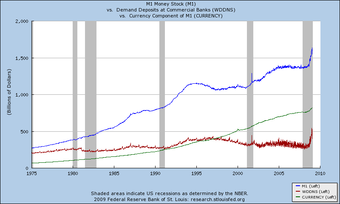
Money supply
In economics, the money supply or money stock, is the total amount of money available in an economy at a specific time.
Money supply data are recorded and published, usually by the government or the central bank of the country. Public and private sector analysts have long monitored changes in money supply because of its possible effects on the price level, inflation and the business cycle.
The different types of money are typically classified as “M”s. The “M”s usually range from M0 (narrowest) to M3 (broadest) but which “M”s are actually used depends on the country’s central bank.
In economics, the monetary base (also base money, money base, high-powered money, reserve money, or, in the UK, narrow money) is a term relating to (but not being equivalent to) the money supply (or money stock) or the amount of money in the economy. The monetary base is highly liquid money that consists of coins, paper money (both as bank vault cash and as currency circulating in the public), and commercial banks’ reserves with the central bank. Measures of money are typically classified as levels of M, where the monetary base is the smallest and lowest M-level: M0. Base money can be described as the most acceptable (or liquid) form of final payment. Broader measures of the money supply also include money that does not count as base money, such as demand deposits (included in M1), and other deposit accounts like the less liquid savings accounts (included in M2), etc. (The narrow money supply is an earlier term used in the U.S. to describe currency held by the non-bank public and demand deposits of banks, M1).
Different Types of Money are Typically Classified as “M”s
- M0: In some countries, such as the United Kingdom, M0 includes bank reserves, so M0 is referred to as the monetary base, or narrow money.
- MB: This is referred to as the monetary base or total currency. This is the base from which other forms of money (like checking deposits) are created and is traditionally the most liquid measure of the money supply.
- M1: Bank reserves are not included in M1.
- M2: Represents money and “close substitutes” for money. M2 is a broader classification of money than M1. Economists use M2 when looking to quantify the amount of money in circulation and trying to explain different economic monetary conditions. M2 is a key economic indicator used to forecast inflation.
- M3: M2 plus large and long-term deposits. Since 2006, M3 is no longer tracked by the U.S. central bank.
The ratio of a pair of these measures, most often M2/M0, is called an (actual, empirical) money multiplier.
Different measures of a nation’s money supply reflect various degrees of asset liquidity, which marks the ease at which a monetary asset can be turned into cash. Liquid assets include coins, paper currency, checkable-type deposits, and traveler’s checks. Less liquid assets include money market deposits and savings account deposits. Measure MI, the most narrow of measures, includes only the most liquid forms of monetary assets; all currency and bank deposits held by a nation’s public. M2, a slightly “broader” measure includes all values incorporated under MI, in addition to assets held in savings accounts, certain time deposits and mutual funds balances.
Money supply is important because it is linked to inflation by the equation of exchange in an equation, MV=PQ, proposed by Irving Fisher in 1911:
- M is the total dollars in the nation’s money supply,
- V is the number of times per year each dollar is spent (velocity of money);
- P is the average price of all the goods and services sold during the year;
- Q is the quantity of assets, goods and services sold during the year.
21.1.4: Control of the Money Supply
A nation’s money supply is determined by the monetary policy actions of its central bank.
Learning Objective
Summarize the argument against the role of open market operations in determining the nation’s money supply
Key Points
- Open market operations, the most dominant instrument of monetary policy, is the behavior of a nation’s central bank to trade or purchase government securities for cash in attempts to expand or contract the total money supply.
- By controlling the national interest rate, a central bank can adequately meet and further dictate the consumer demand for money.
- Under fractional reserve banking, a nation’s central bank is responsible for holding a certain fraction of all deposits as cash or on account with the central bank.
- The central bank’s ability to predict how much money should be in circulation, given current employment rates and inflation rates, is often debated.
Key Terms
- Phillips curve
-
In economics, the Phillips curve is a historical inverse relationship between the rate of unemployment and the rate of inflation in an economy. Stated simply, the lower the unemployment in an economy, the higher the rate of inflation. While it has been observed that there is a stable short run tradeoff between unemployment and inflation, this has not been observed in the long run
- monetary base
-
The monetary base s a term relating to (but not being equivalent to) the money supply; the amount of money in the economy. The monetary base is highly liquid money that consists of coins, paper money (both as bank vault cash and as currency circulating in the public), and commercial banks’ reserves with the central bank.
- open market operations
-
An open market operation (also known as OMO) is an activity by a central bank to buy or sell government bonds on the open market. A central bank uses them as the primary means of implementing monetary policy.
Example
- When a central bank is “easing”, it triggers an increase in money supply by purchasing government securities on the open market thus increasing available funds for private banks to loan through fractional-reserve banking (the issue of new money through loans) and thus the amount of bank reserves and the monetary base rise. By purchasing government bonds (especially Treasury Bills), this bids up their prices, so that interest rates fall at the same time that the monetary base increases.
A nation’s money supply is determined by the monetary policy actions of its central bank. Examples of Central Banks include the Federal Reserve, the Bank of England, and the Bank of Canada, shown here . Commercial banks, as required by the central bank, must keep a fraction of all accepted deposits on reserve either in bank vaults or in central bank deposits. Accordingly, a nation’s central bank can maintain control of such reserves by lending to commercial banks and altering the rate of interest to be charged on such loans. These actions are known as open market operations and allow central banks to achieve a desired level of reserves.
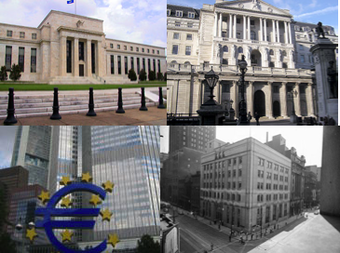
Various Central Banks
Clockwise from top-left: Federal Reserve, Bank of England, European Central Bank, Bank of Canada.
In determining a nation’s money supply, its central bank first sets the supply of the monetary base and upholds certain restrictions on the value of assets and liabilities held by smaller commercial banks. Although the consumer demand for liquidity is dictated by the public, small commercial banks are required to meet consumer demand and do so by identifying certain conditions including a set interest rate which apply to the loaning of bank liabilities. Commercial bank behavior, ultimately regulated by the nation’s central banking institution, and in conjunction with consumer demand define the total stock of money, bank credit, and rates of interest which shape national economic conditions. The value of the money supply is determined by themoney multiplier and the monetary base. The monetary base consists of the total quantity of government-produced money and includes all currency held by the public and reserves held by commercial banks. The central bank retains tight control over its nation’s money supply through the use of open market operations, the discount rate, and reserve requirements.
Open Market Operations
Open market operations, the most dominant instrument of monetary policy, are the behavior of a nation’s central bank to trade or purchase government securities for cash in attempts to expand or contract the total money supply. While purchases of government securities prove to expand the total monetary base, the selling of government securities will ultimately contract a nation’s monetary base.
The Discount Rate
A nation’s central bank is also responsible for supplying commercial banks with enough currency to meet consumer demand. By controlling the national interest rate, a central bank can adequately meet and further dictate the consumer demand for money. A decrease in the interest rate will spark an increase in the consumer demand for money; an increase in the rate of interest will lessen its demand. Changes in the interest rate also play a role in the setting of price levels. Any increase in the demand for money will increase spending levels and cause prices to rise. A decrease in the demand for money will slow spending levels and produce a subsequent decrease in price levels. If consumers expect price levels to fall, the demand for money will increase. If consumers expect price levels to increase, the demand for money will decline.
Reserve Requirements
Under fractional reserve banking, a nation’s central bank is responsible for holding a certain fraction of all deposits as cash or on account with the central bank. Central banks may alter the total money supply by changing the required percentage of total deposits to be held by commercial banks. An increase in reserve requirements would decrease the monetary base; a decrease in the requirements would increase the monetary base.
Criticism
In recent years, some academic economists renowned for their work on the implications of rational expectations have argued that open market operations are irrelevant. The Keynesian side points to a major example of ineffectiveness of open market operations encountered in 2008 in the United States, when short-term interest rates went as low as they could go in nominal terms, so that no more monetary stimulus could occur.
The main functions of the central bank are to maintain low inflation and a low level of unemployment, although these goals are sometimes in conflict (according to Phillips curve). A central bank may attempt to do this by artificially influencing the demand for goods by increasing or decreasing the nation’s money supply (relative to trend), which lowers or raises interest rates, which stimulates or restrains spending on goods and services.
The central bank’s ability to predict how much money should be in circulation, given current employment rates and inflation rates, is often debated. Economists such as Milton Friedman believed that the central bank would always get it wrong, leading to wider swings in the economy than if it were just left alone. This is why they advocated a non-interventionist approach—one of targeting a pre-specified path for the money supply independent of current economic conditions— even though in practice this might involve regular intervention with open market operations (or other monetary-policy tools) to keep the money supply on target.
21.1.5: International Exchange of Money
The foreign exchange market is a form of exchange for international currencies that determines the relative values of different currencies.
Learning Objective
Discuss the factors that influence supply and demand for currencies
Key Points
- Financial centers around the world function as anchors of trading between a wide range of different types of buyers and sellers around the clock, with the exception of weekends.
- The foreign exchange market assists international trade and investment by enabling currency conversion. For example, it permits a business in the United States to import goods from the European Union member states, especially Eurozone members, and pay Euros.
- The foreign exchange market is the most liquid financial market in the world. Traders include large banks, central banks, institutional investors, currency speculators, corporations, governments, other financial institutions, and retail investors.
- At the top is the interbank market, which is made up of the largest commercial banks and securities dealers. Within the interbank market, spreads, which are the difference between the bid and ask prices, are razor sharp and not known to players outside the inner circle.
- Supply and demand for any given currency, and thus its value, are not influenced by any single element, but rather by several. These elements generally fall into three categories: economic factors, political conditions and market psychology.
Key Terms
- floating exchange rate
-
A floating or fluctuating exchange rate is a type of exchange rate regime wherein a currency’s value is allowed to fluctuate according to the foreign exchange market.
- exchange rate
-
An exchange rate between two currencies is the rate at which one currency will be exchanged for another.
- fixed exchange rate
-
Sometimes called a pegged exchange rate, a type of exchange rate regime wherein a currency’s value is matched to the value of another single currency or to a basket of other currencies, or to another measure of value, such as gold.
Example
- For several centuries the developed world operated under a fixed exchange rate system based on the gold standard. The system worked well until WW I and the rapid changes occurring due to industrialization. After the depression in the 1930s, many systems were tried, but the developed world chose to switch back to a fixed exchange rate system after WW II. This was called the Bretton Woods system and included the creation of the IMF (International Monetary Fund).
In finance, an exchange rate (also known as the foreign-exchange rate, forex rate or FX rate) between two currencies is the rate at which one currency will be exchanged for another. It is also regarded as the value of one country’s currency in terms of another currency. For example, an interbank exchange rate of 91 Japanese yen (JPY, ¥) to the United States dollar (US$) means that ¥91 will be exchanged for each US$1 or that US$1 will be exchanged for each ¥91. Exchange rates are determined in the foreign exchange market, which is open to a wide range of different types of buyers and sellers where currency trading is continuous (24 hours a day except weekends, i.e., trading from 20:15 GMT on Sunday until 22:00 GMT Friday). The spot exchange rate refers to the current exchange rate. The forward exchange rate refers to an exchange rate that is quoted and traded today but for delivery and payment on a specific future date .
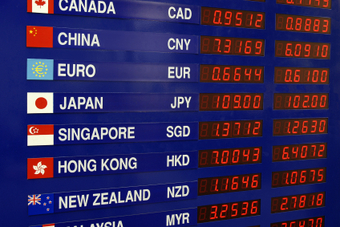
Exchange Rate
In finance, an exchange rate (also known as the foreign-exchange rate, forex rate or FX rate) between two currencies is the rate at which one currency will be exchanged for another.
In a typical foreign exchange transaction, a party purchases a quantity of one currency by paying a quantity of another currency. The modern foreign exchange market began forming during the 1970s after three decades of government restrictions on foreign exchange transactions (the Bretton Woods system of monetary management established the rules for commercial and financial relations among the world’s major industrial states after World War II), when countries gradually switched to floating exchange rates from the previous exchange rate regime, which remained fixed as per the Bretton Woods system.
The foreign exchange market (forex, FX, or currency market) is a form of exchange for the global decentralized trading of international currencies. Financial centers around the world function as anchors of trading between a wide range of different types of buyers and sellers around the clock, with the exception of weekends. The foreign exchange market determines the relative values of different currencies.
The foreign exchange market assists international trade and investment by enabling currency conversion. For example, it permits a business in the United States to import goods from the European Union member states, especially Eurozone members, and pay Euros, even though its income is in United States dollars. It also supports direct speculation in the value of currencies, and the carry trade, speculation based on the interest rate differential between two currencies.
21.2: Credit
21.2.1: Obtaining Credit
Credit is a term used to denote transactions involving the transfer of money or other property on promise of repayment.
Learning Objective
Describe the concept of credit and how consumers can obtain in for transaction purposes
Key Points
- Credit encompasses any form of deferred payment. Credit does not necessarily require money. The credit concept can be applied in barter economies as well, based on the direct exchange of goods and services.
- Obtaining credit is dependent on the reputation or creditworthiness of the entity which takes responsibility for the funds.
- In the U.S., when a customer fills out an application for credit from a bank, store or credit card company, their information is forwarded to a credit bureau.
- Lenders like to see consumer debt obligations paid regularly and on time, and therefore focus particularly on missed payments and may not, for example, consider an overpayment as an offset for a missed payment. The other factor in determining whether a lender will provide a consumer credit or a loan is dependent on income. The higher the income, all other things being equal, the more credit the consumer can access.
Key Terms
- creditor
-
A person to whom a debt is owed.
- debtor
-
A person or firm that owes money; one in debt; one who owes a debt
- credit report
-
A document of the history and current status of a borrower’s credit standing, and may include identifying information, credit information, public-records information, recent inquiries and credit score.
Example
- A credit card company, which is a type of creditor, will look at information about the potential customer, or debtor, from a credit bureau in order to determine if the company will lend to the potential customer. The credit card company uses the credit report, provided by the credit bureau, to determine if the lender is likely to pay back the loan. The credit history includes information about past borrowing and repaying behavior of the customer.
Credit, in commerce and finance, is a term used to denote transactions involving the transfer of money or other property on promise of repayment, usually at a fixed future date. The transferor thereby becomes a creditor, and the transfer, a debtor; hence credit and debt are simply terms describing the same operation viewed from opposite standpoints.Credit encompasses any form of deferred payment. Credit does not necessarily require money. The credit concept can be applied in barter economies as well, based on the direct exchange of goods and services (Ingham 2004 p. 12-19). However, in modern societies credit is usually denominated by a unit of account. Unlike money, credit itself cannot act as a unit of account. Types of credit include: bank credit, consumer credit, public credit, and investment credit.
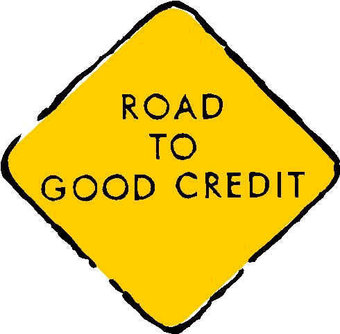
Good Credit
Credit, in commerce and finance, is a term used to denote transactions involving the transfer of money or other property on promise of repayment, usually at a fixed future date.
Obtaining credit is dependent on the reputation or creditworthiness of the entity which takes responsibility for the funds. Credit is also traded in financial markets. The purest form is the credit default swap market, which is essentially a traded market in credit insurance. A credit default swap represents the price at which two parties exchange this risk – the protection “seller” takes the risk of default of the credit in return for a payment, commonly denoted in basis points (one basis point is 1/100 of a percent) of the notional amount to be referenced, while the protection “buyer” pays this premium and in the case of default of the underlying (a loan, bond or other receivable), delivers this receivable to the protection seller and receives from the seller the par amount (that is, is made whole)
Credit history or credit report is, in many countries, a negative record of an individual’s or company’s past borrowing and repaying, including information about late payments and bankruptcy. The term “credit reputation” can either be used synonymous to credit history or to credit score.
In the U.S., when a customer fills out an application for credit from a bank, store or credit card company, their information is forwarded to a credit bureau. The credit bureau matches the name, address and other identifying information on the credit applicant with information retained by the bureau in its files. That’s why it’s very important for creditors, lenders and others to provide accurate data to credit bureaus.
This information is used by lenders such as credit card companies to determine an individual’s credit worthiness; that is, determining an individual’s ability and track record of repaying a debt. The willingness to repay a debt is indicated by how timely past payments have been made to other lenders. Lenders like to see consumer debt obligations paid regularly and on time, and therefore focus particularly on missed payments and may not, for example, consider an overpayment as an offset for a missed payment.
The other factor in determining whether a lender will provide a consumer credit or a loan is dependent on income. The higher the income, all other things being equal, the more credit the consumer can access. However, lenders make credit granting decisions based on both ability to repay a debt (income) and willingness (the credit report) as indicated by a history of regular, unmissed payments. These factors help lenders determine whether to extend credit, and on what terms.
21.2.2: The Five Cs of Credit
Capacity to repay, capital, collateral, conditions, and character, are referred to as the “Five Cs of Credit”.
Learning Objective
Name the Five Cs of credit
Key Points
- Capacity to repay, the most critical of the five factors, indicates to the prospective lender exactly how an individual intends to repay a loan. The lender will consider the cash flow from the business, the timing of the repayment, and the probability of successful repayment of the loan.
- Capital is the value of assets that a debtor currently holds. Potential lenders may expect an individual to communicate their current assets so as to indicate their ability to pay back a loan.
- Collateral is additional form of security you can provide the lender. Giving a lender collateral means that you pledge an asset you own, such as your home, to the lender with the agreement that it will be the repayment source in case you can’t repay the loan.
- Conditions focus on the intended purpose of the loan. Will the money be used for working capital, additional equipment, or inventory? The lender also will consider the local economic climate and conditions both within your industry and in other industries that could affect your business.
- Character is the general impression you make on the potential lender or investor. The lender will form a subjective opinion as to whether or not you are sufficiently trustworthy to repay the loan or generate a return on funds invested in your company.
Key Terms
- collateral
-
A security or guarantee (usually an asset) pledged for the repayment of a loan if one cannot procure enough funds to repay. (Originally supplied as “accompanying” security. )
- capital
-
Money and wealth. The means to acquire goods and services, especially in a non-barter system.
- loan
-
A sum of money or other valuables or consideration that an individual, group, or other legal entity borrows from another individual, group, or legal entity (the latter often being a financial institution) with the condition that it be returned or repaid at a later date (sometimes with interest).
Example
- How might a potential lender use information about a debtor’s capital? For example, a business owner’s capital would be how much they have personally invested in the business and is an indication of how much you have at risk should the business fail. Prospective lenders and investors will expect you to have contributed from your own assets and to have undertaken personal financial risk to establish the business before asking them to commit any funding.
The Five Cs of Credit
Capacity to repay is the most critical of the five factors. The prospective lender will want to know exactly how an individual intends to repay a loan. The lender will consider the cash flow from the business, the timing of the repayment, and the probability of successful repayment of the loan. Payment history on existing credit relationships—personal or commercial—is considered an indicator of future payment performance. Prospective lenders also will want to know about your contingent sources of repayment. Other relevant information includes already existing debts that a debtor may hold.
Capital is the value of assets that a debtor currently holds. A business owner’s capital, for instance, would be how much they have personally invested in the business and is an indication of how much you have at risk should the business fail. Prospective lenders and investors will expect you to have contributed from your own assets and to have undertaken personal financial risk to establish the business before asking them to commit any funding .

Capital
Capital is the value of assets that a debtor currently holds.
Collateral, or guarantees, are additional forms of security that you can provide the lender. Giving a lender collateral means that you pledge an asset you own, such as your home, to the lender with the agreement that it will become the repayment source if you can’t repay the loan. A guarantee, on the other hand, is just that: someone else signs a guarantee document promising to repay the loan if you can’t. Some lenders may require such a guarantee in addition to collateral as security for a loan.
Conditions focus on the intended purpose of the loan. Will the money be used for working capital, additional equipment, or inventory? The lender also will consider the local economic climate and conditions both within your industry and in other industries that could affect your business.
Character is the general impression you make on the potential lender or investor. The lender will form a subjective opinion as to whether or not you are sufficiently trustworthy to repay the loan or generate a return on funds invested in your company. Your employment background and experience in business and in your industry will be reviewed. The quality of your references and the background and experience levels of your employees also will be taken into consideration. A person who seems to have a stable background, indicated by steady employment and housing, is more likely to seem trustworthy to lenders.
An additional, often cited “C” of credit, is credit history, which looks at the debtor’s past uses of credit. Evidence of responsible use and repayment of credit is a good sign to lenders.
21.2.3: Credit Ratings
A credit rating evaluates the credit worthiness of a debtor, specifically a business (company), individual, or a government.
Learning Objective
Distinguish between corporate credit ratings and individual credit ratings
Key Points
- Credit ratings are determined by credit ratings agencies. The credit rating represents the credit rating agency’s evaluation of qualitative and quantitative information for a company or government; including non-public information obtained by the credit rating agencies analysts.
- A short-term rating is a probability factor of an individual going into default within a year. This is in contrast to a long-term rating, which is evaluated over a long time frame.
- A sovereign credit rating is the credit rating of a sovereign entity like a national government. The sovereign credit rating indicates the risk level of the investing environment of a country and is used by investors looking to invest abroad. It takes political risk into account.
- In the United States, an individual credit score is a number based on a statistical analysis of a person’s credit files, that in theory represents the creditworthiness of that person.
- Starting in the early 1970s, the “Big Three” ratings agencies (S&P, Moody’s, and Fitch) began to receive payment for their work by the securities issuers for whom they issue those ratings, which has led to charges that these ratings agencies can no longer always be impartial when issuing ratings for those securities issuers. This problem of vested interests has been cited as one of the primary causes of the subprime mortgage crisis (which began in 2007), when some securities, particularly mortgage backed securities (MBSs) and collateralized debt obligations (CDOs) rated highly by the credit ratings agencies, and thus heavily invested in by many organizations and individuals, were rapidly and vastly devalued due to defaults, and fear of defaults, on some of the individual components of those securities, such as home loans and credit card accounts.
Key Terms
- revolving credit agreement
-
a type of debt that does not have a fixed number of payments
- default
-
The condition of failing to meet an obligation.
- bond
-
Evidence of a long-term debt, by which the bond issuer (the borrower) is obliged to pay interest when due, and repay the principal at maturity, as specified on the face of the bond certificate. The rights of the holder are specified in the bond indenture, which contains the legal terms and conditions under which the bond was issued. Bonds are available in two forms: registered bonds and bearer bonds.
Examples
- How might credit ratings affect companies and other entities that issue debt? Credit ratings may determine, for example, how much a firm or government has to pay to access credit markets (i.e., the amount of interest they pay on their issued debt).
- How might credit ratings affect companies and other entities that issue debt? Credit ratings may determine, for example, how much a firm or government has to pay to access credit markets (i.e., the amount of interest they pay on their issued debt. )
Credit Ratings
A credit rating evaluates the credit worthiness of a debtor, especially a business (company) or a government. It is an evaluation made by a credit rating agency of the debtor’s ability to pay back the debt and the likelihood of default. Credit ratings are determined by credit ratings agencies. The credit rating represents the credit rating agency’s evaluation of qualitative and quantitative information for a company or government; including non-public information obtained by the credit rating agencies analysts. Credit ratings are not based on mathematical formulas. Instead, credit rating agencies use their judgment and experience in determining what public and private information should be considered in giving a rating to a particular company or government. The credit rating is used by individuals and entities that purchase the bonds issued by companies and governments to determine the likelihood that the government will pay its bond obligations.
A poor credit rating indicates a credit rating agency’s opinion that the company or government has a high risk of defaulting, based on the agency’s analysis of the entity’s history and analysis of long term economic prospects.
Sovereign Credit Ratings
A sovereign credit rating is the credit rating of a sovereign entity like a national government. The sovereign credit rating indicates the risk level of the investing environment of a country and is used by investors looking to invest abroad. Ratings are broken down into components including political and economic risk. Euromoney’s bi-annual country risk index monitors the political and economic stability of 185 sovereign countries. Results focus foremost on economics, specifically sovereign default risk and/or payment default risk for exporters (a.k.a. trade credit risk).
The top 10 least risky countries, as of June 2011 are as follows:
- Norway
- Luxembourg
- Switzerland
- Denmark
- Sweden
- Singapore
- Finland
- Canada
- Netherlands
- Germany
Corporate Ratings
A short-term rating is a probability factor of an individual going into default within a year. This is in contrast to a long-term rating, which is evaluated over a long time frame. First, the Basel II agreement requires banks to report their one-year probability if they applied internal ratings-based approach for capital requirements. Second, many institutional investors can easily manage their credit/bond portfolios with derivatives on monthly or quarterly basis. Therefore, some rating agencies simply report short-term ratings.
The credit rating of a corporation is a financial indicator to potential investors of debt securities, such as bonds. The corporate credit rating is usually of a financial instrument such as a bond, rather than the whole corporation. These are assigned by credit rating agencies such as A. M. Best, Dun & Bradstreet, Standard & Poor’s, Moody’s, or Fitch. Ratings have letter designations such as A, B, C. Bond ratings below BBB/Baa are considered to be not investment grade and are colloquially called junk bonds.
Ratings play a critical role in determining how much companies and other entities that issue debt, including sovereign governments, have to pay to access credit markets, such as the amount of interest they pay on their issued debt. The threshold between investment-grade and speculative-grade ratings has important market implications for issuers’ borrowing costs.
Bonds that are not rated as investment-grade bonds are known as high yield bonds or more derisively as junk bonds. The risks associated with investment-grade bonds (or investment-grade corporate debt) are considered significantly higher than those associated with first-class government bonds. The difference between rates for first-class government bonds and investment-grade bonds is called investment-grade spread. The range of this spread is an indicator of the market’s belief in the stability of the economy. The higher these investment-grade spreads (or risk premiums) are, the weaker the economy is considered.
Individual Ratings
In the United States, a credit score is a number based on a statistical analysis of a person’s credit files, that in theory represents the creditworthiness of that person, which is the likelihood that people will pay their bills. A credit score is primarily based on credit report information, typically from one of the three major credit bureaus: Experian, TransUnion, and Equifax. Income is not considered by the major credit bureaus when calculating a credit score.
There are different methods of calculating credit scores. FICO, the most widely known type of credit score, is a credit score developed by FICO, previously known as Fair Isaac Corporation. It is used by many mortgage lenders that use a risk-based system to determine the possibility that the borrower may default on financial obligations to the mortgage lender. All credit scores have to be subject to availability.
The credit bureaus all have their own credit scores: Equifax’s ScorePower, Experian’s PLUS score, and TransUnion’s credit score, and each also sells the VantageScore credit score. In addition, many large lenders, including the major credit card issuers, have developed their own proprietary scoring models.
Studies have shown scores to be predictive of risk in the underwriting of both credit and insurance. Some studies even suggest that most consumers are the beneficiaries of lower credit costs and insurance premiums due to the use of credit scores.
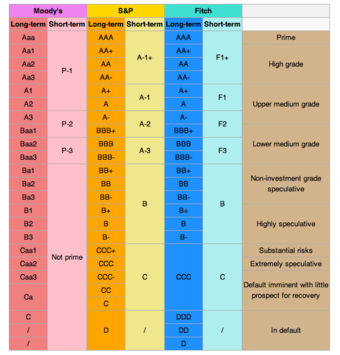
Bond Credit Ratings
Each credit rating agency designates the quality of bonds with letters. This table shows each agency and their respective rating systems.
21.2.4: Collection from Delinquent Payables
Debt compliance describes various legal measures taken to ensure that debtors honor their debts.
Learning Objective
Explain the ramifications of failing to repay credit card and loan debts
Key Points
- A charge-off is the declaration by a creditor that an amount of debt is unlikely to be collected. This occurs when a consumer becomes severely delinquent on a debt. Traditionally, creditors will make this declaration at the point of six months without payment.
- The purpose a charge-off is to give the bank a tax exemption on the debt. However, the charge-off declaration does not free the debtor of having to pay the debt.
- While a charge-off is considered to be “uncollectible” by the bank, the debt is still legally valid and remains as such after the fact. The creditor legally has the right to collect the full amount for a period of time permitted by the laws where the bank is and the consumer reside.
- While a charge-off is considered to be “written off as uncollectable” by the bank, the debt is still legally valid, and remains as such after the fact. The creditor legally has the right to collect the full amount for a time periods permitted the laws of places of the location of the bank and where the consumer resides.
Key Terms
- audit
-
An independent review and examination of records and activities to assess the adequacy of system controls, to ensure compliance with established policies and operational procedures, and to recommend necessary changes in controls, policies, or procedures.
- compliance
-
The accuracy with which a patient follows an agreed treatment plan.
- debt
-
Money that one person or entity owes or is required to pay to another, generally as a result of a loan or other financial transaction.
Examples
- If an individual does not repay borrowed money to a credit card company and 6 months of nonpayment have passed, the credit card company may declare a “charge-off. ” This means that the debt is “written off as uncollectable,” so that the credit card company will get a tax exemption on that debt. The debtor does not get off scott-free, however. The “charge-off” declaration severely negatively impacts the debtor’s credit report and the creditor still has the legal right to collect the full amount over a period of time, depending on permitted local laws.
- There are a number of repercussions for debt noncompliance. For example, a provision of the Federal Debt Collection Procedure Act states that a person or organization indebted to the United States, against whom a judgment lien has been filed, is ineligible to receive a government grant.
Collection from delinquent payables
In finance, the term “debt compliance” describes various legal measures taken to ensure that debtors, whether individuals, businesses, or governments, honor their debts and make an honest effort to repay the money that they owe. Generally, regarded as a subdivision of tax law, debt compliance is most often enforced through a combination of audits and legal restrictions. For example, a provision of the Federal Debt Collection Procedure Act states that a person or organization indebted to the United States, against whom a judgment lien has been filed, is ineligible to receive a government grant. Noncompliance, depending on severity and frequency, may be punished by fine or even incarceration. A charge-off is the declaration by a creditor (usually a credit card account) that an amount of debt is unlikely to be collected. This occurs when a consumer becomes severely delinquent on a debt. Traditionally, creditors will make this declaration at the point of six months without payment. In the United States, Federal regulations require creditors to charge-off installment loans after 120 days of delinquency, while revolving credit accounts must be charged-off after 180 days.Figure 1
The purpose of making such a declaration is to give the bank a tax exemption on the debt. Bad debts and even fraud are simply part of the cost of doing business. The charge-off, though, does not free the debtor of having to pay the debt. A charge-off is one of the most adverse factors that can be listed on an individual’s credit report, greatly impacting an individual’s ability to get credit in the future.
While a charge-off is considered to be “written off as uncollectible” by the bank, the debt is still legally valid, and remains as such after the fact. The creditor legally has the right to collect the full amount for time periods permitted by the laws of places of the location of the bank and where the consumer resides. Depending on the location, this amount of time may be a certain number of years (e.g., 3 to 7 years), or in some places, indefinitely.
Methods of collection that can be used include contacts from internal collections staff, outside collection agencies, or if the amount is large (generally over $1500–$2000), there is the possibility of a lawsuit or arbitration. In the United States, as the charge off number climbs or becomes erratic, officials from the Federal Reserve take a close look at the finances of the bank and may impose various operating strictures on the bank and in the most extreme cases, may close the bank entirely.
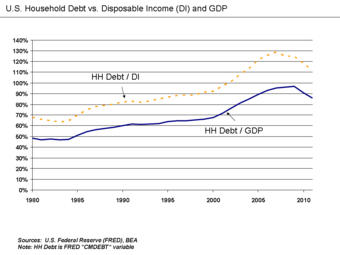
U.S. Household Debt Relative to Disposable Income and GDP 1980-2011
A charge-off is the declaration by a creditor (usually a credit card account) that an amount of debt is unlikely to be collected.
21.2.5: Trends in Credit After 2008
The economic collapse of 2008 had substantial impacts on the banking industry and the availability of credit for borrowers.
Learning Objective
Consider the impact of the 2008 economic collapse on the credit market
Key Points
- The 2008 economic collapse, also referred to as the Sub-Prime Crisis and the Great Recession, had enormous and far-reaching implications on the nature of banking.
- It is important to understand what caused this crisis: irresponsible lending coupled with dishonest description of these loans through bundling them into derivatives. As a result, the process of lending money saw increased scrutiny.
- This massive amount of irresponsible credit lending is well-evidenced by the subsequent foreclosures on millions upon millions of homes in the United States alone between 2007-2015.
- Stipulations on borrowing, such as verification of income and a minimum down payment, have been implemented when pursuing credit.
- Interest rates have remained low despite despite the credit crunch, primarily to incentive spending to spur the economy back into growth.
Key Terms
- derivatives
-
In finance, this is an investment option defined as being valued via the variable valuation of another asset.
- foreclosures
-
Following a default on credit, the lending party is allowed to recapture the capital by repossessing assets (such as the property the money was borrowed to purchase).
The Great Recession, The Housing Bubble, the Sub-Prime Crisis, the Depression of 2007-08— the financial crisis in 2008 is known by quite a few names. When considering the causes of the financial disaster, it is important to note that governments, banks, investors, and borrowers made some bad decisions. At the center of these bad decisions was the lending of capital (credit) to individuals who were unlikely to be able to repay it.
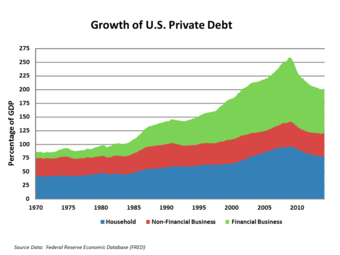
Debt to GDP Ratio
This chart demonstrates the overall percentage of debt owned by governments, companies, and individuals relative to overall GDP. The spike shows how credit before the 2008 disaster was easily obtained (irresponsibly so), and post 2008 the reaction has been a reversal of that trend (albeit, temporarily).
This resulted in what’s called a credit crunch. The credit crunch from the 2008 economic disaster was quite significant, and the scale of the financial collapse was enormous.
Credit Crunch Post-2008
Foreclosures
To understand the trends in decreased lending by the banks, it’s useful to observe the increases in foreclosures (demonstrated risk) that underline the risk banks are taking in the current economy:
- 2007: 2,203,295 foreclosures were filed on 1,285,873 properties during the year, up 75 percent from 2006.
- 2008: 3,157,806 foreclosures were filed on 2,330,483 properties during the year, up 81 percent from 2007.
- 2009: 3,957,643 foreclosures were filed on 2,824,674 properties during the year, up 21 percent from 2008.
- 2010: 3,825,637 foreclosures were filed on 2,871,891 properties during 2010, up nearly 2 percent from the previous year.
- 2011: 1,887,777 properties received foreclosure notices during the year, down 34 percent from last year.
- 2012: 1,836,634 properties received foreclosure notices during the year, down 3 percent from last year.
- 2013: 1,361,795 properties received foreclosure notices during the year, down 26 percent from last year.
- 2014: 1,117,426 properties received foreclosure notices in 2014, a 18 percent decrease over 2013.
- 2015: 1,083,572 properties received foreclosure notices in 2015, a 3 percent decrease over 2014.
Lending
With the above foreclosures in mind, banks were not particularly eager to repeat their past mistakes by offering credit to anyone (and bundling these mortgages into derivatives supposedly labeled as low risk AAA securities, a highly misleading practice that contributed substantially to the problem). As a result, lending became more stringent in terms of proof of income and the required down payments.
Prior to the turn of the 21st century, it was common practice to provide 20% down payment on a loan, alongside providing proof of income (in the United States, that is). Indeed, most developing countries require these types of proofs for a sizable loan such as a mortgage. These rules were removed in the United States, leading the 21st century into a massive increase in homeowner borrowing. Addressing this was a primary concern after the 2008 collapse, building in safety measures to mitigate risk in borrowing for home purchasing.
That being said, spending is good for the economy, so interest rates became quite low post 2008. This is somewhat unusual for a credit crunch, as low interest rates stimulate borrowing. However, creating spend is one tactic for reversing an economic recession, and this is exactly what was done.
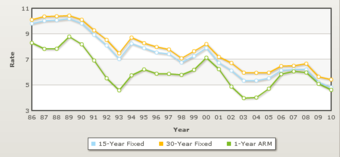
Mortgage Rates (US)
This chart shows the rates of interest incurred by borrowers over time in the US mortgage market, most notably highlighting the relative decrease in overall interest rates even after the Great Recession.
21.3: American Banking
21.3.1: Non-Bank Financial Institutions
A non-bank financial institution offers customers bank-related services such as payday lending, cashier’s checks, and check cashing.
Learning Objective
Describe the services offered by non-bank financial institutions
Key Points
- Non-bank financial institutions such as payday lenders will offer consumers relatively small-dollar, short-term, cash loans at a high interest rate.
- While the nature of the loans offered by non-bank financial institutions are not ideal for financing a major purchase like a home or an automobile, they serve as a crucial last resort for those facing an emergency.
- Financial services are equally important in protecting against the unforeseen consequences of natural disasters, war, illness, incapacity or death of a breadwinner, and other crises.
Key Terms
- non-bank financial institution
-
A financial institution that does not have a full banking license or one that is not supervised by a national or international banking regulatory agency.
- currency
-
Money or other items used to facilitate transactions.
Services from Non-Bank Financial Institutions
A non-bank financial institution (NBFI) is a financial institution that does not have a full banking license or is not supervised by a national or international banking regulatory agency. NBFIs facilitate bank-related financial services, such as investments, risk pooling, contractual savings, and market brokering. Examples of these include insurance firms, pawn shops, cashier’s check issuers, check cashing locations, payday lending, currency exchanges, and microloan organizations. Alan Greenspan has identified the role of NBFIs in strengthening an economy, as they provide “multiple alternatives to transform an economy’s savings into capital investment which act as backup facilities should the primary form of intermediation fail. “
Financial services are equally important in protecting against the unforeseen consequences of natural disasters, war, illness, incapacity or death of a breadwinner, and other crises. With financial services, poor families can send their children to school, buy medicine, and get through lean times when cash and food are scarce. Despite the importance of financial services for both poverty reduction and equitable economic growth, experts estimate that only five percent of low-income households around the world have access to such services. The international development community, with a vision it calls “financial sector deepening,” is promoting the extension of diverse financial services by a wide range of bank and non-bank financial institutions to ever larger numbers of low-income and middle-class households around the world.
High-Cost Loans
You have probably seen ads for check-cashing stores, payday loans, and rent-to-own stores. You may be intrigued by the services they offer. But these short-term financial fixes can cost you big bucks because they are ostensibly high-cost loans. Make sure you understand what you’re agreeing to and can afford to pay back your loan before you sign any documents. Consider your options to taking a high-cost loan and use loans wisely.
Check-Cashing Establishments
If you don’t have a checking or savings account, you might think check-cashing stores are a convenient alternative. Understand, however, check-cashing stores charge you for that convenience. Many check-cashing stores charge a fee of $4 for every $100 on a payroll check. That means if you have a $700 payroll check, you’re paying $28 just to cash it. For $28 you might be able to fill your car with gas or buy groceries. For personal checks, these establishments charge even more .
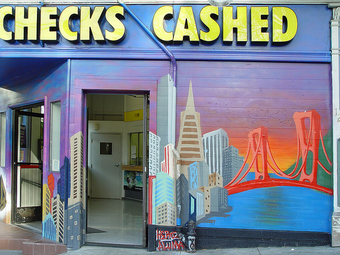
Mural: Checks Cashed
Check-cashing institution on Haight Street, San Francisco, California
Payday Lenders
Many check-cashing stores also make payday loans. A payday loan is a small, high-interest, short-term cash loan. In most cases, you write a post-dated, personal check for the advance amount, plus a fee. The payday lender holds the check for the loan period and then deposits it, or you return with cash to reclaim the check. Although a payday loan may be a convenient short-term solution, it is not a good idea for long-term cash needs. You run the risk of getting into a payday loan cycle of debt by taking out loan after loan
21.3.2: Commercial Banks
Commercial banks enable business by providing access to resources and risk-mitigating exchanges.
Learning Objective
Perceive the role of commercial banks from the business sense, and recognize the variety of risks banks encounter as a result
Key Points
- Commercial banks offer consumers the ability to conduct most of their financial business through a single institution.
- Recently, the U.S. banking industry has become more commercial. Commercial banks generally deal with mid-sized to larger businesses, though due to high consolidation in the industry, they also offer various retail services.
- By enabling the exchange of capital and currency on a global scale via various investment mediums, commercial banks enable businesses with valuable resources.
- While banks offer a wide range of services, the primary service a bank offers revolves around exchanging various capital assets to access funding and mitigate risks.
- Banks themselves must combat a variety of risks themselves, as they are essentially in the business of taking strategic risks. These risks come in a variety of forms.
- The 2008 economic collapse is a strong example of how commercial banks impact the broader economy, and the potential repercussions of failing to manage risk.
Key Term
- Risk management
-
Offsetting potential financial exposures through strategic investments.
Commercial banks are financial institutions that focus on enabling the exchange of capital and currency via a variety of services. For the most part, the term commercial bank refers to divisions of banks that deal primarily with mid-sized to large businesses.
Banking Commercially
When considering commercial banks, it’s useful to understand that they act as an outlet for strategic financial decisions for businesses to offset certain risks, procure resources, invest, and store assets. These services generally include the following:
- Enabling bank accounts, used to store, exchange, send, and receive capital electronically (generally via the internet)
- Providing loans and other lending services, at established rates of interest
- Safekeeping of documents and valuables via safe deposit boxes
- Enabling the purchase of a wide variety of investment options
- Risk management (i.e. foreign exchange risks, interest rates, hedging commodities, derivatives)
- Project financing
- Raising capital (i.e. IPOs and other forms of commercial capital raising)
While banks offer other services in addition to these, the primary function of commercial banks is to act as a critical resource for businesses to access capital, enable investments, and mitigate risks.
Banking Risks and Economic Issues
Banking is, in many ways, in the business of risk. It is in measuring these risks that banks determine their interest rates and fees. There are a few types of risks banks encounter, which are useful in understanding how banks function:
- Credit Risk – Risk that a borrower may not return the entirety of the payment owed.
- Liquidity Risk – Risk that an acquired asset cannot be traded quickly enough to capture profit.
- Market Risk – Virtually any capital asset has a market, and is therefore subjected to the risks of it’s respective market.
- Operational Risk – Risk that an operational issue will diminish returns.
- Reputation Risk – Risk that a company’s trustworthiness will decline.
- Macroeconomic Risk – Risk that the broader economy will decline.
The economic collapse in 2008, partly as a result of banks failing to accurately identify and ethically respond to risk, is a strong example of the consequences of banking failures.
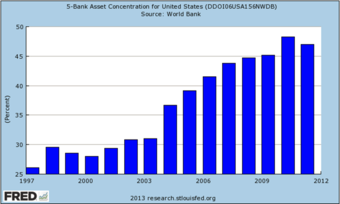
Percent of Industry Assets Owned by the Largest 5 Banks
This image demonstrated the ongoing consolidation of the banking industry, through displaying the overall assets owned by the largest 5 banks.
21.3.3: Savings and Loan Associations (S&Ls)
A savings and loan association is a special kind of deposit institution that only participates in a subsection of financial activities.
Learning Objective
Define a savings and loan association, and its role in the American banking system
Key Points
- A savings and loan association primarily earns income by lending the deposits held at their institution by other members.
- Savings and loan associations tend to be smaller and less complex than commercial banks.
- Savings and loan associations and cooperative banks were established during the 1800s to help factory workers and other wage earners become homeowners.
Key Terms
- savings and loan association
-
A financial institution that specializes in accepting savings deposits and making mortgage and other loans.
- credit union
-
A financial cooperative similar to a bank but owned and controlled by its members, often restricted to a local area or sometimes to a single profession.
A savings and loan association (or S&L), also known as a thrift, is a financial institution that specializes in accepting savings deposits and making mortgage and other loans. The terms “S&L” or “thrift” are mainly used in the United States; similar institutions in the United Kingdom, Ireland, and some Commonwealth countries include building societies and trustee savings banks. They are often mutually held (often called mutual savings banks), meaning that the depositors and borrowers are members with voting rights, and have the ability to direct the financial and managerial goals of the organization like the members of a credit union or the policyholders of a mutual insurance company. While it is possible for an S&L to be a joint stock company, and even publicly traded, in such instances it is no longer truly a mutual association, and depositors and borrowers no longer have membership rights and managerial control. By law, thrifts must have at least 65% of their lending in mortgages and other consumer loans, making them particularly vulnerable to housing downturns, such as the deep one the United States has experienced since 2007.
Savings and loan associations and cooperative banks were established during the 1800s to help factory workers and other wage earners become homeowners. S&Ls accepted savings deposits and used the money to make loans to home buyers. Most of the loans went to people who did not make enough money to be welcomed at traditional banks.
The savings and loan association became a strong force in the early twentieth century through assisting people with home ownership, through mortgage lending, and further assisting their members with basic saving and investing outlets, typically through passbook savings accounts and term certificates of deposit.

Banking district in China
All three note-issuing banks are in this shot: Bank of China, HSBC (Hongkong and Shanghai Banking Corporation), and Standard Chartered Bank.
21.3.4: Credit Unions
Credit unions offer local communities unique banking benefits by empowering local ownership and reinvesting in the community.
Learning Objective
Assess the value of credit unions, particularly compared to big banks and an understanding of risk
Key Points
- Credit unions act as a substitute to traditional larger banks, focusing on providing local communities full ownership, voting rights, and funding through their emphasis on people rather than profits.
- There are a variety of benefits when choosing a credit union instead of a bank, primarily revolving around supporting the community, minimizing risk, and achieving lower rates.
- Credit unions also come with their fair share of downsides, most notably easy global accessibility, the benefits of scale, and access to riskier investment options.
- When making a banking decision, consumers must carefully consider the pros and cons of credit unions before making a decision.
Key Terms
- Credit unions
-
Cooperative banking institutions focused more on people and community, as opposed to profitability and global scale.
- mitigating risk
-
Reducing the potential for losing capital, as well as gaining larger returns, through investing in more volatile options.
Not A Bank
Credit unions are substitutes and competitors of banks, owned by members as a financial cooperative. As a result, credit unions tend to be smaller forms of cooperative banks that avoid borrowing, and operate solely upon the funding and liquidity enabled by the resources deposited by members.
The primary difference between a credit union and a bank from an operational perspective is best described via the decision-making system. The board of directors for a credit union is traditionally elected through a vote of all existing members, where each member gets one vote (regardless of the amount of capital one has invested). Credit unions pride themselves on being community-oriented, deliberately mitigating risk and serving people as opposed to pursuing profit.
The Pros and Cons
There are a variety of valid reasons to support credit unions, as well as a few downsides consumers should also be aware of:
The Good
- Credit unions commit resources to the local community.
- Credit unions usually offer better rates on deposits and lower costs for loans
- Credit unions offer access to borrowing options not always available at traditional banks
- Credit unions provide more personalized service
- Credit unions increase competition (big banks tend to be oligopolies, while credit unions are intrinsically smaller in scale, thus high in quantity)
The Risks
- Credit unions are usually region specific, so traveling can have some complexities in terms of support
- Credit unions are smaller, and therefore more likely to go out of business
- Credit unions are more vulnerable to risk, and thus may not be as willing as larger banks to lend money without confidence in repayment
While there are many considerations to be made when deciding on a banking option, credit unions are uniquely positioned to offset the downsides of big banks through avoiding risk while focusing on local needs. Big banks add advantage through scale (along with risk), providing more investment opportunities and global access to capital.
21.4: Trends in Banking
21.4.1: Electronic Banking
Electronic banking includes such services as ATMs, direct deposits, electronic fund transfers, and online banking.
Learning Objective
Discuss common electronic banking features and services
Key Points
- ATMs can be used to to make a withdrawal, make a deposit, make a loan payment, transfer money from one account to another, or check your account balance.
- Direct deposit makes it possible for you to have your money electronically added to your checking account every payday.
- Electronic funds transfer (EFT) is a service that allows a bank to transfer large amounts of money to another bank by sending an electronic message.
Key Term
- overdraft
-
The act of overdrawing a bank account.
Electronic Banking
The emergence of new technologies has turned banking into a round-the-clock business. Automated teller machines (ATMs) now make it possible for you to do much of your banking whenever you choose . ATMs are computers that are much like limited-service bank branches. You can use them to make a withdrawal, make a deposit, make a loan payment, transfer money from one account to another, or check your account balance. In many cases, automated teller machines of different banks are linked together in networks so you can use them when you travel to a different town, another state, or even another country. All you need is a plastic card from your bank and your own password.

ATM
ATMs are computers that are much like limited-service bank branches. You can use them to make a withdrawal, make a deposit, make a loan payment, transfer money from one account to another, or check your account balance.
Another electronic banking service available today is direct deposit. This service makes it possible for you to have your money electronically added to your checking account every payday. Instead of receiving a paycheck, you receive a statement that tells you your money has been deposited in your account. Direct deposit is popular among people who receive Social Security checks or pension checks because it saves them the trouble of travelling to the bank to deposit them in person.
Electronic funds transfer (EFT) is a service that allows a bank to transfer large amounts of money to another bank by sending an electronic message. Electronic transfers take only an instant. An electronic message instructs a computer to deduct a certain amount of money from one bank account and then add the same amount to another bank account. The message is sent, and the appropriate amount is transferred. No cash or paper changes hands, but money is transferred just the same.
Possibly the most popular advance in banking through the use of technology is online banking. The emergence of online banking has ushered in a new era of convenience and security in managing money. The service is available seven days a week, 24 hours a day. The system gives you the freedom to choose your own banking hours, giving you greater control of your finances. It’s secure, fast, and easy to use. Online banking allows you to check your balance, pay your bills, view statements, transfer funds, view transaction history, and much more. Online banking services include:
- Getting provisional statements
- Making account payments
- Making a once-off payment
- Setting up future-dated payments
- Setting up repeat payments
- Making inter-account transfers
- Stopping debit orders and checks
- Increasing and decreasing overdraft limits
Banks have found online banking so much cheaper than traditional in-bank methods that some have encouraged depositors and other customers to bank from home or via machines by charging them fees for the privilege of talking to a teller! Some banks are completely virtual and have no physical branches. So-called click-and-mortar, or hybrid, banks appear more viable than completely virtual banks at present.
Further technological advances have led to the creation of automated banking machines (ABMs). ABMs are combinations of ATMs, web sites, and dedicated customer service telephone lines that allow customers to make deposits, transfer funds between accounts, or engage in even more sophisticated banking transactions without stepping foot in the bank.
21.4.2: Online Direct Banks
An online direct bank has no physical branches, relying only on internet, phone, and mail services and often delivering better rates to customers.
Learning Objective
Describe direct banking and the drivers behind its success
Key Points
- By eliminating the costs associated with bank branches, direct banks may offer higher interest rates and lower service charges on their products than their traditional competitors.
- The commercialization of the Internet in the early 1990s was the biggest driver in the creation of direct banking models.
- The initial success of internet banking services provided by traditional banks led to the development of internet-only banks or “virtual banks”.
Key Term
- automated teller machine
-
A device that provides bank customers with cash withdrawal and other services without the need for a bank teller.
Direct Banking
A direct bank is a bank without any branch network. It offers its financial services by:
- Telephone banking
- Online banking
- Automated teller machines (often through interbank network alliances)
- Mail banking
- Or mobile banking
By eliminating the costs associated with bank branches, direct banks may offer higher interest rates and lower service charges on their products than their traditional competitors. Direct banks were originally based on providing banking services via telephone. One of the world’s first fully functional direct banks was First Direct, which launched in the United Kingdom on October 1, 1989. First Direct pioneered the concepts of no branches and 24-hour service from a call center.
The commercialization of the Internet in the early 1990s was the biggest driver in the creation of direct banking models. As the Internet became more generally accessible, traditional banks began to realize their potential to deliver services to their customers while reducing long-term operational costs. Upon realizing this, traditional banks began to offer limited online banking services. The initial success of internet banking services provided by traditional banks led to the development of internet-only banks or “virtual banks. ” These banks were designed without a traditional banking infrastructure, a cost-saving feature that allowed many of them to offer savings accounts with higher interest rates and loans with lower interest rates than most traditional banks.
One of the first fully functional direct banks in the United States was the Security First Network Bank (SFNB). Based in Atlanta, it was the first direct bank to be insured by the Federal Deposit Insurance Corporation (FDIC). Though SFNB did not make much profit in its initial years, it demonstrated that the concept of direct banking could work.
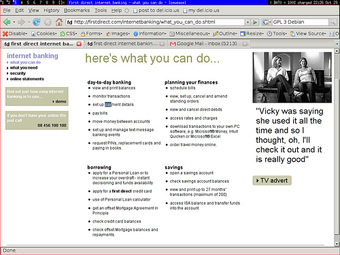
Online Direct Banking
A list of services offered by the First Direct Bank.
21.4.3: Personal Financial Management
Personal finance is the application of the principles of finance to the monetary decisions of an individual or family.
Learning Objective
Give examples of personal financial management
Key Points
- Having rules to dictate when and how much money you set aside for personal savings will help you avoid over-consumption.
- Personal savings should always be kept in the form of liquid assets. This way, should you befall some kind of tragedy, your money will be readily available.
- With all of the financial, investment, and insurance products available to consumers, it is worthwhile to learn about your options in order to find a personal financial management strategy that fits your goals and risk preferences.
Key Terms
- insurance
-
A means of indemnity against a future occurrence of an uncertain event.
- mutual funds
-
A mutual fund is a type of professionally-managed collective investment vehicle that pools money from many investors to purchase securities.
- finance
-
the science of management of money and other assets
Personal Finance Defined
Personal finance is the application of the principles of finance to the monetary decisions of an individual or family. It addresses the ways in which individuals or families obtain, budget, save, and spend monetary resources over time, taking into account various financial risks and future life events. When planning personal finances there are many financial products one might consider: such as banking products (checking, savings accounts, credit cards, and consumer loans), investment products (stock market, bonds, and mutual funds), and insurance products (life insurance, health insurance, and disability insurance). One might also consider individual or employer sponsored retirement plans, social security benefits, and income tax management.
Personal Finance Strategies
Here are ways to start saving more:
Have an emergency savings account. This is an account you can tap into if you lose your job or have major, unforeseen expenses. “Emergency savings will help ensure that you don’t have to borrow from your retirement nest egg or take out additional loans that would push you into debt,” said Luke W. Reynolds, Chief of the FDIC’s Community Affairs Outreach Section. A general rule of thumb is to have enough money in this “rainy day” fund equal to at least two months of living expenses. If your employment outlook is especially uncertain, consider setting aside enough to cover six or more months of anticipated expenses.
Also, keep your emergency savings in an account that will be fairly liquid — such as a bank savings account, money market account, or a short-term certificate of deposit (CD) — so you can withdraw the money relatively quickly, if necessary. “You should probably also keep your emergency money in a deposit account, where your funds are protected by federal deposit insurance, as opposed to stocks or stock or bond mutual funds that can lose value in a volatile market,” said Mary Bass, an FDIC Senior Community Affairs Specialist. Try to save money for long-term goals, such as your retirement. If your employer matches a portion of your payroll contributions to a tax-advantaged retirement savings plan, “not participating means you are passing up free money and perhaps losing out on a valuable tax break,” added Reynolds.
Pay yourself first. That means each month, before you’re tempted to spend money, commit to putting a good bit of it into a savings account. You can write out a check to be deposited into your savings account, but it’s much easier to arrange with your bank to automatically transfer a certain amount from your paycheck or your checking account into your savings. And as you pay your bills, your mortgage and other obligations, take satisfaction in knowing that some of your hard-earned dollars are already saved for you!
Start small. “By consistently saving small amounts, even $25 out of every paycheck, your savings account will grow and you will be motivated to try to save more,” said Reynolds. “Even that spare change you put once a month into a bank savings account can add up faster than you think. “
Review your existing accounts and comparison shop for the best deals. Look at what is being offered by your bank and a few competitors. The idea is to make sure the interest rates are competitive and that the fees and features are appropriate for how you use each account. For example, if your money is sitting in a low-rate checking or savings account, consider moving it to a higher-yielding account, perhaps a CD where the earnings can get an extra boost. Turn a debt payment into a deposit. If you pay off a debt, such as the outstanding balance on a credit card, or if you make that last loan payment on your car, put that money to work as part of your savings.
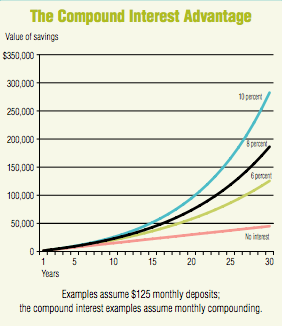
Compound Interest
The chart to the left shows how compound interest at various rates would increase Lynne’s savings compared with simply putting the money in a shoebox. This is compound interest that you earn. And as you can see from an investment, compounding has a greater effect after the investment and interest have increased over a longer period.
21.5: The Federal Reserve System
21.5.1: Introduction to the Federal Reserve
The Federal Reserve System is the central banking system of the United States, which conducts the nation’s monetary policy.
Learning Objective
Describe the primary function and objectives of the Federal Reserve System
Key Points
- By changing the money supply through buying or selling government bonds, the Fed can alter the short-term interest rates. This lowers interest rates, which can stimulate borrowing, spending, and investment, in theory.
- The Fed also supervises and regulates banking institutions, maintains the stability of the financial system, and provides financial services to depository institutions, the government, and foreign institutions.
- The Congress established three key objectives for monetary policy—maximum employment, stable prices, and moderate long-term interest rates.
- The Fed acts independently; it does not have to answer to the president or Congress.
Key Terms
- Federal Reserve System
-
the central banking system in the United States
- monetary policy
-
The process by which the government, central bank, or monetary authority manages the supply of money, or trading in foreign exchange markets.
- depression
-
a period of major economic contraction
What is the Federal Reserve?
The Federal Reserve System (also known as the Federal Reserve, or the “Fed”) is the central banking system of the United States. It was created on December 23, 1913 with the enactment of the Federal Reserve Act, largely in response to a series of financial panics. Over time, the roles and responsibilities of the Federal Reserve System have expanded, and its structure has evolved. Events, such as the Great Depression, were major factors leading to changes in the system.
Congress established three key objectives for monetary policy—maximum employment, stable prices, and moderate long-term interest rates—in the Federal Reserve Act. Its duties have expanded over the years, and today, according to official Federal Reserve documentation, include conducting the nation’s monetary policy, supervising and regulating banking institutions, maintaining the stability of the financial system, and providing financial services to depository institutions, the U.S. government, and foreign official institutions.
The Fed is independent within government in that “its monetary policy decisions do not have to be approved by the President or anyone else in the executive or legislative branches of government. ” Its authority is derived from statutes enacted by the U.S. Congress, and the system is subject to congressional oversight. The members of the board of governors, including its chairman and vice-chairman, are chosen by the president and confirmed by the Senate.
Since the inflation of the 1970s, Federal Reserve monetary policy has emphasized preventing rapid escalation of general price levels. When the general price level is rising too fast, the Federal Reserve acts to slow economic expansion by reducing the money supply, thus raising short-term interest rates.
When the economy is slowing down too fast or contracting, the Federal Reserve increases the money supply, thus lowering short-term interest rates. The most common way it effects these changes in interest rates, called “open-market operations,” is by buying and selling government securities among a small group of major banks and bond dealers.
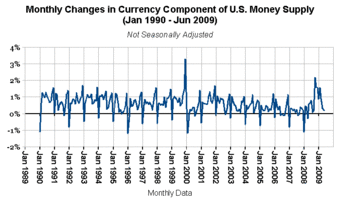
Monthly changes in the currency component of the U.S. money supply as reported by the Federal Reserve
21.5.2: Banking Crises and Centralized Reserve Enforcements
One of the Federal Reserve’s duties is to regulate financial institutions, such as bank-holding companies and state member banks.
Learning Objective
Discuss the Federal Reserve’s powers for enforcing actions due to violations
Key Points
- Generally, the Federal Reserve takes formal enforcement actions against banks for violations of laws, rules, or regulations, unsafe or unsound practices, breaches of fiduciary duty, and violations of final orders.
- Formal enforcement actions include cease and desist orders, written agreements, removal and prohibition orders, and orders assessing civil money penalties.
- The Federal Reserve supervises certain entities and has the statutory authority to take formal enforcement actions against them.
Key Term
- Federal Reserve
-
the central banking system of the United States
The Federal Reserve supervises certain entities and has the statutory authority to take formal enforcement actions against them, including state member banks, bank holding companies, nonbank subsidiaries of bank holding companies, branches and agencies of foreign banking organizations operating in the United States and their parent banks, and officers, directors, employees, and certain other categories of individuals associated with the above banks, companies, and organizations.
Generally, the Federal Reserve takes formal enforcement actions against the above entities for violations of laws, rules, or regulations, unsafe or unsound practices, breaches of fiduciary duty, and violations of final orders. Formal enforcement actions include cease and desist orders, written agreements, removal and prohibition orders, and orders assessing civil money penalties.
Enforcement
If the Federal Reserve determines that a state member bank or bank holding company has problems that affect the institution’s safety and soundness or is not in compliance with laws and regulations, it may take a supervisory action to ensure that the institution undertakes corrective measures. Typically, such findings are communicated to the management and directors of a banking organization in a written report. The management and directors are then asked to address all identified problems voluntarily and to take measures to ensure that the problems are corrected and will not recur.
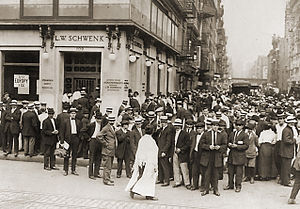
Bank failure
If the Federal Reserve determines that a state member bank or bank holding company has problems that affect the institution’s safety and soundness or is not in compliance with laws and regulations, it may take a supervisory action to ensure that the institution undertakes corrective measures.
Most problems are resolved promptly after they are brought to the attention of an institution’s management and directors. In some situations, however, the Federal Reserve may need to take an informal supervisory action, requesting that an institution adopt a board resolution or agree to the provisions of a memorandum of understanding to address the problem. If necessary, the Federal Reserve may take formal enforcement actions to compel the management and directors of a troubled banking organization, or persons associated with it, to address the organization’s problems. For example, if an institution has significant deficiencies or fails to comply with an informal action, the Federal Reserve may enter into a written agreement with the troubled institution or may issue a cease-and-desist order against the institution or against an individual associated with the institution, such as an officer or director. The Federal Reserve may also assess a fine, remove an officer or director from office and permanently bar him or her from the banking industry, or both.
21.5.3: The Lender of Last Resort
The U.S. Federal Reserve as the “lender of last resort” extends credit to financial institutions unable to obtain credit elsewhere.
Learning Objective
Explain why the Federal Reserve serves as the “lender of last resort”
Key Points
- There has been some criticism of this particular Fed function, as it shifts responsibility away from lenders and borrowers and adversely affects other parties in the form of inflation.
- Through its discount and credit operations, Reserve Banks provide liquidity to banks to meet short-term needs stemming from seasonal fluctuations in deposits or unexpected withdrawals.
- The rate the Fed charges banks for these loans is the discount rate (officially the primary credit rate).
Key Term
- liquidity
-
An asset’s ability to become solvent without affecting its value; the degree to which it can be easily converted into cash.
Example
- The Fed’s role as lender of last resort played a large role in the aftermath of the 2008 Financial Crisis. The Fed provided loans to support a number of institutions from collapse, including AIG, Bank of America, and Morgan Stanley.
In the United States, the Federal Reserve serves as the lender of last resort to those institutions that cannot obtain credit elsewhere and the collapse of which would have serious implications for the economy. It took over this role from the private sector “clearing houses” which operated during the Free Banking Era; whether public or private, the availability of liquidity was intended to prevent bank runs.
According to the Federal Reserve Bank of Minneapolis, “the Federal Reserve has the authority and financial resources to act as ‘lender of last resort’ by extending credit to depository institutions or to other entities in unusual circumstances involving a national or regional emergency, where failure to obtain credit would have a severe adverse impact on the economy. ” Through its discount and credit operations, Reserve Banks provide liquidity to banks to meet short-term needs stemming from seasonal fluctuations in deposits or unexpected withdrawals. Longer term liquidity may also be provided in exceptional circumstances. The rate the Fed charges banks for these loans is the discount rate (officially the primary credit rate).
By making these loans, the Fed serves as a buffer against unexpected day-to-day fluctuations in reserve demand and supply. This contributes to the effective functioning of the banking system, alleviates pressure in the reserves market and reduces the extent of unexpected movements in the interest rates. For example, on September 16, 2008, the Federal Reserve Board authorized an $85 billion loan to stave off the bankruptcy of international insurance giant American International Group (AIG).
The Federal Reserve System’s role as lender of last resort has been criticized because it shifts the risk and responsibility away from lenders and borrowers and places it on others in the form of inflation.
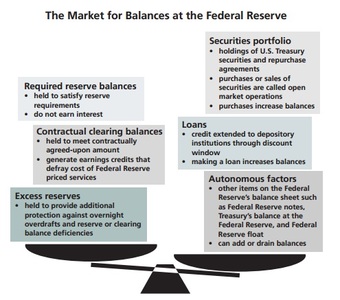
The Market for Balances at the Federal Reserve
21.5.4: The Fed as a Check Clearer
The Fed created a nationwide check-clearing system that provided an efficient and stable way of transferring funds between institutions.
Learning Objective
Explain why a check clearing system was created under the Federal Reserve system
Key Points
- The government of the United States of America is the federal government of the constitutional republic of 50 states that constitute the United States, as well as one capitol district and several other territories.
- A check-clearing system was created in the Federal Reserve system after banks refused to clear checks from certain others during times of economic uncertainty.
- The system, then, was to provide not only an elastic currency—that is, a currency that would expand or shrink in amount as economic conditions warranted—but also an efficient and equitable check-collection system.
Key Term
- Check-clearing
-
The movement of a check from the depository institution at which it was deposited back to the institution on which it was written; the movement of funds in the opposite direction and the corresponding credit and debit to the accounts involved.
Example
- Person A writes a check for $10 and gives it to Person B, who brings it to his banking institution. This part is where the check moves from the depository institution (Person B’s bank) to the institution on which it was drawn (Person A’s). If there are sufficient funds in Person A’s account, the face value of the check ($10 in this case) then moves from A to B, resulting in a debit of $10 to Person A and a credit of $10 to Person B.
The Fed as a Check Clearer
The government of the United States of America is the federal government of the constitutional republic of 50 states that constitute the United States, as well as one capitol district, and several other territories. The federal government is composed of three distinct branches: legislative, executive, and judicial, with powers vested by the U.S. Constitution in the Congress, the President, and the federal courts, including the Supreme Court, respectively; the powers and duties of these branches are further defined by acts of Congress, including the creation of executive departments and courts inferior to the Supreme Court.
Check clearing is defined as “the movement of a check from the depository institution at which it was deposited back to the institution on which it was written, the movement of funds in the opposite direction, and the corresponding credit and debit to the accounts involved. Check clearing also encompasses the return of a check (for insufficient funds, for example) from the bank on which it was written to the bank at which it was deposited, and the corresponding movement of funds. “
Because some banks refused to clear checks from certain others during times of economic uncertainty, a check-clearing system was created in the Federal Reserve system. By creating the Fed, Congress intended to eliminate the severe financial crises that had periodically swept the nation, especially the sort of financial panic that occurred in 1907. During that episode, payments were disrupted throughout the country because many banks and clearinghouses refused to clear checks drawn on certain other banks, a practice that contributed to the failure of otherwise solvent banks. To address these problems, Congress gave the Federal Reserve System the authority to establish a nationwide check-clearing system. The system, then, was to provide not only an elastic currency—that is, a currency that would expand or shrink in amount as economic conditions warranted—but also an efficient and equitable check-collection system.

measures of aggregate balances, 2001-2004
Billions of dollars
21.5.5: The Reserve Requirement
The Federal Reserve is in charge of setting reserve requirements for all depository institutions in the country.
Learning Objective
Discuss what happens when the Fed increases or decreases the reserve requirement
Key Points
- Reserve requirements are the amount of assets against liabilities that depository institutions must hold in reserve.
- A bank’s liabilities are their financial obligations; for instance, if a customer deposits $100 in the bank, that is a liability because the bank must have that $100 to give back if the customer decides to withdraw their money.
- Requiring depository institutions to hold a certain fraction of their deposits in reserve (either as cash in their vaults or as non-interest-bearing balances at the Federal Reserve) directly affects availability of credit.
- An increase in the reserve requirement reduces the amount banks are free to lend out, so this is a contraction in credit that leads to an increase in interest rates. The opposite is true if there is a decrease in the reserve requirement.
Key Terms
- liabilities
-
An amount of money in a company that is owed to someone and has to be paid in the future, such as tax, debt, interest, and mortgage payments.
- reserve requirement
-
The amount of funds that a depository institution must hold in reserve against specified deposit liabilities.
Example
- Suppose that the Fed sets the reserve ratio at 10% for net transaction accounts between $6 million and $15 million. If a bank has deposits totalling $10 million, it must have 10% of that on reserve, so that’s $1 million that the bank cannot lend out.
Reserve requirements have long been a part of the United States banking history. Depository institutions maintain a fraction of certain liabilities in reserve in specified assets. The Federal Reserve can adjust reserve requirements by changing required reserve ratios, the liabilities to which the ratios apply, or both. Changes in reserve requirements can have profound effects on the money stock and on the cost to banks of extending credit and are also costly to administer; therefore, reserve requirements are not adjusted frequently. Nonetheless, reserve requirements play a useful role in the conduct of open market operations by helping to ensure a predictable demand for Federal Reserve balances and thus enhancing the Federal Reserve’s control over the federal funds rate.
Requiring depository institutions to hold a certain fraction of their deposits in reserve, either as cash in their vaults or as non-interest-bearing balances at the Federal Reserve, does impose a cost on the private sector. The cost is equal to the amount of forgone interest on these funds—or at least on the portion of these funds that depository institutions hold only because of legal requirements and not to meet their customers’ needs.
Changes in reserve requirements can affect the money stock, by altering the volume of deposits that can be supported by a given level of reserves, and bank funding costs. Unless it is accompanied by an increase in the supply of Federal Reserve balances, an increase in reserve requirements (through an increase in the required reserve ratio, for example) reduces excess reserves, induces a contraction in bank credit and deposit levels, and raises interest rates. It also pushes up bank funding costs by increasing the amount of non-interest-bearing assets that must be held in reserve. Conversely, a decrease in reserve requirements, unless accompanied by a reduction in Federal Reserve balances, initially leaves depository institutions with excess reserves, which can encourage an expansion of bank credit and deposit levels and reduce interest rates.
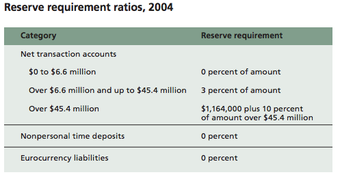
Reserve Requirement
Reserve Requirement Ratios, 2004
21.5.6: The Discount Rate
The Fed makes loans to depository institutions and charges different discount rates for each of discount windows.
Learning Objective
Describe the Fed’s primary credit, secondary credit, and seasonal credit lending programs
Key Points
- The Fed offers three discount window programs to depository institutions: primary credit, secondary credit, and seasonal credit, each with its own interest rate. All discount window loans are fully secured.
- The discount rate charged for primary credit (the primary credit rate) is set above the usual level of short-term market interest rates.
- The discount rate on secondary credit is above the rate on primary credit.
- The discount rate for seasonal credit is an average of selected market rates.
Key Terms
- discount rate
-
The interest rate charged to commercial banks and other depository institutions on loans they receive from their regional Federal Reserve Bank’s lending facility.
- Discount window
-
The discount window is an instrument of monetary policy (usually controlled by central banks) that allows eligible institutions to borrow money from the central bank, usually on a short-term basis, to meet temporary shortages of liquidity caused by internal or external disruptions.
The discount rate is the interest rate charged to commercial banks and other depository institutions on loans they receive from the Fed’s lending facility, the discount window. The Fed offers three discount window programs to depository institutions: primary credit, secondary credit, and seasonal credit, each with its own interest rate. All discount window loans are fully secured.
Under the primary credit program, loans are extended for a very short term (usually overnight) to depository institutions in generally sound financial condition. Depository institutions that are not eligible for primary credit may apply for secondary credit to meet short-term liquidity needs or to resolve severe financial difficulties. Seasonal credit is extended to relatively small depository institutions that have recurring intra-year fluctuations in funding needs, such as banks in agricultural or seasonal resort communities.
The discount rate charged for primary credit (the primary credit rate) is set above the usual level of short-term market interest rates. (Because primary credit is the Federal Reserve’s main discount window program, the Federal Reserve, at times, uses the term “discount rate” to mean the primary credit rate. ) The discount rate on secondary credit is above the rate on primary credit. The discount rate for seasonal credit is an average of selected market rates. Discount rates are established by each reserve bank’s board of directors, subject to the review and determination of the Federal Reserve System’s Board of Governors. The discount rates for the three lending programs are the same across all reserve banks except on days around a change in the rate.
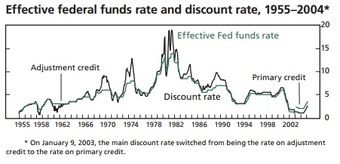
Discount rate
Effective Federal funds rate and discount rate, 1955-2004
21.5.7: Open Market Operations
Open market operations (OMO) refer to a central bank’s selling or buying of government bonds on the open market.
Learning Objective
Define the role and function of an open market operation (OMO)
Key Points
- The Fed’s primary tool in conducting monetary policy is open market operations, which involves the Fed buying or selling securities (usually U.S. treasury bonds) on the open market.
- The Fed’s open market account (their securities holdings associated with open market operations) is composed mostly of U.S. Treasury securities with remaining maturities of one year or less. This allows the Fed to change the composition of its assets quickly, if necessary.
- Buying or selling the bonds changes the supply of base money in the economy, affecting the interest rates.
- The Federal Open Market Committee (FOMC) oversees open market operations.
- In theory, the Federal Reserve could conduct open market operations by purchasing or selling any type of asset. In practice, however, most assets cannot be traded readily enough to accommodate open market operations.
Key Terms
- Open Market Operation
-
an activity by a central bank to buy or sell government bonds on the open market.
- monetary policy
-
The process by which the government, central bank, or monetary authority manages the supply of money, or trading in foreign exchange markets.
Example
- If the economy is contracting, the Fed would want lower interest rates to stimulate borrowing and spending again. They can achieve this through expansionary monetary policy, buying government bonds and increasing the money supply.
Open Market Operation
An open market operation (also known as OMO) is an activity by a central bank (in the U.S. it is the Fed) to buy or sell government bonds on the open market. A central bank uses them as the primary means of implementing monetary policy. The usual aim of open market operations is to control the short term interest rate and the supply of base money in an economy, and thus indirectly control the total money supply. This involves meeting the demand of base money at the target interest rate by buying and selling government securities, or other financial instruments. Monetary targets, such as inflation, interest rates, or exchange rates, are used to guide this implementation.
In theory, the Federal Reserve could conduct open market operations by purchasing or selling any type of asset. In practice, however, most assets cannot be traded readily enough to accommodate open market operations. For open market operations to work effectively, the Federal Reserve must be able to buy and sell quickly, at its own convenience, in whatever volume may be needed to keep the federal funds rate at the target level. These conditions require that the instrument it buys or sells be traded in a broad, highly active market that can accommodate the transactions without distortions or disruptions to the market itself. The market for U.S. Treasury securities satisfies these conditions. The U.S. Treasury securities market is the broadest and most active of U.S. financial markets. Transactions are handled over the counter, not on an organized exchange. Although most of the trading occurs in New York City, telephone and computer connections link dealers, brokers, and customers—regardless of their location—to form a global market.
Composition of the Federal Reserve’s Portfolio
The overall size of the Federal Reserve’s holdings of Treasury securities depends principally on the growth of Federal Reserve notes; however, the amounts and maturities of the individual securities held depends on the FOMC’s preferences for liquidity. A sizable share of the Federal Reserve’s holdings is held in Treasury securities with remaining maturities of one year or less. This structure provides the Federal Reserve with the ability to alter the composition of its assets quickly when developments warrant. At the end of 2004, the Federal Reserve’s holdings of Treasury securities were about evenly weighted between those with maturities of one year or less and those with maturities greater than one year.
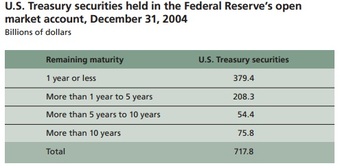
U.S. Treasury securities held in the Federal Reserve’s open market account, December 31, 2004
In billions of dollars.
21.6: Protection of Funds
21.6.1: The Federal Deposit Insurance Corporation (FDIC)
The Federal Deposit Insurance Corporation is an independent agency whose mandate is to maintain stability and public confidence in financial system.
Learning Objective
Discuss the history and role of the FDIC
Key Points
- The FDIC promotes public confidence in the U.S. financial system by insuring depositors for at least $250,000 per insured bank.
- The FDIC receives no Congressional appropriations; it is funded by premiums that banks and thrift institutions pay for deposit insurance coverage and from earnings on investments in U.S. Treasury securities.
- The FDIC insures deposits only. It does not insure securities, mutual funds, or similar types of investments that banks and thrift institutions may offer.
- The FDIC was created in 1933 in response to the thousands of bank failures that occurred in the 1920s and early 1930s.
Key Term
- FDIC
-
The Federal Deposit Insurance Corporation (FDIC) is a United States government corporation operating as an independent agency that provides deposit insurance, which guarantees the safety of deposits in member banks, up to $250,000 per depositor per bank.
Example
- As of April 16, 2012, the members of the Board of Directors of the FDIC are Martin J. Gruenberg (Acting Chairman of the Board), Thomas M. Hoenig, Jeremiah O. Norton, Thomas J. Curry (Comptroller of the Currency), and Richard Cordray (Director, Consumer Financial Protection Bureau).
The Federal Deposit Insurance Corporation (FDIC)
The Federal Deposit Insurance Corporation (FDIC) is an independent agency created by the Congress to maintain stability and public confidence in the nation’s financial system by insuring deposits, examining and supervising financial institutions for safety and soundness and consumer protection, and managing receiverships. The FDIC promotes public confidence in the United States financial system by insuring depositors for at least $250,000 per insured bank. This is accomplished by identifying, monitoring, and addressing risks to the deposit insurance funds and by limiting the effect on the economy and the financial system when a bank or thrift institution fails.
An independent agency of the federal government, the FDIC was created in 1933 in response to the thousands of bank failures that occurred in the 1920s and early 1930s. Since the start of FDIC insurance on January 1, 1934, no depositor has lost a single cent of insured funds as a result of a failure. The FDIC receives no Congressional appropriations; it is funded by premiums that banks and thrift institutions pay for deposit insurance coverage and from earnings on investments in U.S. Treasury securities. The FDIC insures more than $7 trillion of deposits in U.S. banks and thrifts—deposits in virtually every bank and thrift in the country .
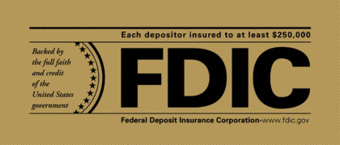
FDIC
The Federal Deposit Insurance Corporation (FDIC) is an independent agency created by the Congress to maintain stability and public confidence in the nation’s financial system.
United States banks and credit unions are closely regulated and supervised to ensure that consumer money is safe. Banks and credit unions are required to comply with regulations.The Federal Deposit Insurance Corporation (FDIC) insures deposit accounts for banks and the National Credit Union Administration for credit unions.
In order to counter banks that engage in excessive risk taking, programs were developed for early intervention. The FDIC Improvement Act of 1991 limits regulators’ discretion as to when to close troubled financial institutions (FIs). It requires that troubled FIs be recognized long before they become insolvent. For example, within 90 days of detection, critically undercapitalized FIs with tangible equity of less than 2% of assets must be placed in conservatorship or receivership. Public FIs can also utilize specific regulations to reallocate portfolios in ways that are deemed to be financially sound and socially beneficial. A good example is the prohibition against lending more than 10% of a bank’s capital to any one borrower.
21.6.2: The National Credit Union Administration (NCUA)
The NCUA is the independent federal agency created by the U.S. Congress to regulate, charter, and supervise federal credit unions.
Learning Objective
Describe the NCUA and its role in the United States
Key Points
- As the insurer and regulator of Federally chartered credit unions, the NCUA oversees credit union safety and soundness, much like the FDIC.
- To protect against the failure of credit unions, NCUA implemented a 12-month examination cycle for federally insured credit unions to detect problems in individual credit unions before they became insurmountable.
- The NCUA is governed by a three-member board appointed by the President of the United States and confirmed by the United States Senate. The president also chooses which member will serve in the position of chairman.
Key Term
- NCUA
-
The National Credit Union Administration (NCUA) is the independent federal agency created by the U.S. Congress to regulate, charter, and supervise federal credit unions.
Example
- On March 20, 2009, during the financial crisis of 2007–2010, the NCUA took over the two largest corporate credit unions with combined assets of $57 billion, because of the losses on their investments in mortgage-backed securities.
The National Credit Union Administration (NCUA)
The National Credit Union Administration (NCUA) is the United States independent federal agency that supervises and charters federal credit unions. NCUA also insures savings in federal- and most state-chartered credit unions across the country through the National Credit Union Share Insurance Fund (NCUSIF), a federal fund backed by the full faith and credit of the United States government. The chartering of credit unions in all states is due to the signing of the Federal Credit Union Act by President Franklin D. Roosevelt in 1934 as part of the New Deal. The federal law sought to make credit available and promote thrift through a national system of nonprofit, cooperative credit unions.
At first, the newly created Bureau of Federal Credit Unions was housed at the Farm Credit Administration. Responsibility for regulation would shift over the years as the agency migrated from the Federal Deposit Insurance Corporation to the Federal Security Agency, then to the Department of Health, Education, and Welfare.
As the insurer and regulator of federally chartered credit unions, the NCUA oversees credit union safety and soundness, much like the FDIC. It is sometimes required to place credit unions in conservatorship. On March 20, 2009, during the financial crisis of 2007–2010, the NCUA took over the two largest corporate credit unions with combined assets of $57 billion because of the losses on their investments in mortgage-backed securities.
The National Credit Union Share Insurance Fund (NCUSIF) is the federal fund created by Congress in 1970 to insure member’s deposits in federally insured credit unions. On July 22, 2010, the Dodd-Frank Wall Street Reform and Consumer Protection Act was signed into law and included permanently establishing the NCUA’s standard maximum share insurance amount at $250,000. All deposit insurance resources reflect this higher level of coverage. Credit unions may also offer an array of additional financial services which are not covered by federal insurance.
21.6.3: The Savings Association Insurance Fund (SAIF)
Between 1989 and 2006, there were two separate FDIC funds–Bank Insurance Fund (BIF), and Savings Association Insurance Fund (SAIF).
Learning Objective
Explain why the Bank Insurance Fund and the Savings Association Insurance Fund were merged into the Deposit Insurance Fund
Key Points
- The existence of two separate funds for the same purpose led to banks attempting to shift from one fund to another, depending on the benefits each could provide. In the 1990s, SAIF premiums were, at one point, five times higher than BIF premiums.
- In February 2006, President George W. Bush signed into law the Federal Deposit Insurance Reform Act of 2005 (FDIRA), which resulted in the merging of the Bank Insurance Fund (BIF) and the Savings Association Insurance Fund (SAIF) into a new fund, the Deposit Insurance Fund (DIF).
- Bank failures typically represent a cost to the DIF, because the FDIC, as receiver of the failed institution, must liquidate assets that have declined substantially in value while, at the same time, making good on the institution’s deposit obligations.
Key Term
- SAIF
-
One of the two FDIC fund between 1989 and 2006, after which it merged with the Bank Insurance Fund to form the Deposit Insurance Fund in 2006
Example
- In the 1990s, SAIF premiums were, at one point, five times higher than BIF premiums; several banks attempted to qualify for the BIF, with some merging with institutions qualified for the BIF to avoid the higher premiums of the SAIF. This drove up the BIF premiums as well, resulting in a situation where both funds were charging higher premiums than necessary.
Between 1989 and 2006, there were two separate FDIC funds—the Bank Insurance Fund (BIF) and the Savings Association Insurance Fund (SAIF). The latter was established after the savings and loans crisis of the 1980s. The existence of two separate funds for the same purpose led to banks attempting to shift from one fund to another, depending on the benefits each could provide. In the 1990s, SAIF premiums were, at one point, five times higher than BIF premiums. Alan Greenspan, Chairman of the Federal Reserve, was a critic of the system, saying, “We are, in effect, attempting to use government to enforce two different prices for the same item – namely, government-mandated deposit insurance. Such price differences only create efforts by market participants to arbitrage the difference.” Greenspan proposed “to end this game and merge SAIF and BIF” .
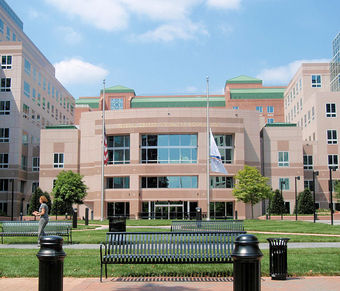
FDIC office in Arlington, VA
Between 1989 and 2006, there were two separate FDIC funds—the Bank Insurance Fund (BIF), and the Savings Association Insurance Fund (SAIF).
In February 2006, President George W. Bush signed into law the Federal Deposit Insurance Reform Act of 2005 (FDIRA),which contained changes to implement deposit insurance reform, as well as a number of study and survey requirements. Among the highlights of this law was merging the BIF and the SAIF into a new fund, the Deposit Insurance Fund (DIF). This change was made effective March 31, 2006. The FDIC maintains the DIF by assessing depository institutions an insurance premium. The amount each institution is assessed is based both on the balance of insured deposits, as well as on the degree of risk the institution poses to the insurance fund.
Typically, bank failures represent a cost to the DIF because the FDIC, as receiver of the failed institution, must liquidate assets that have declined substantially in value while, at the same time, making good on the institution’s deposit obligations.
